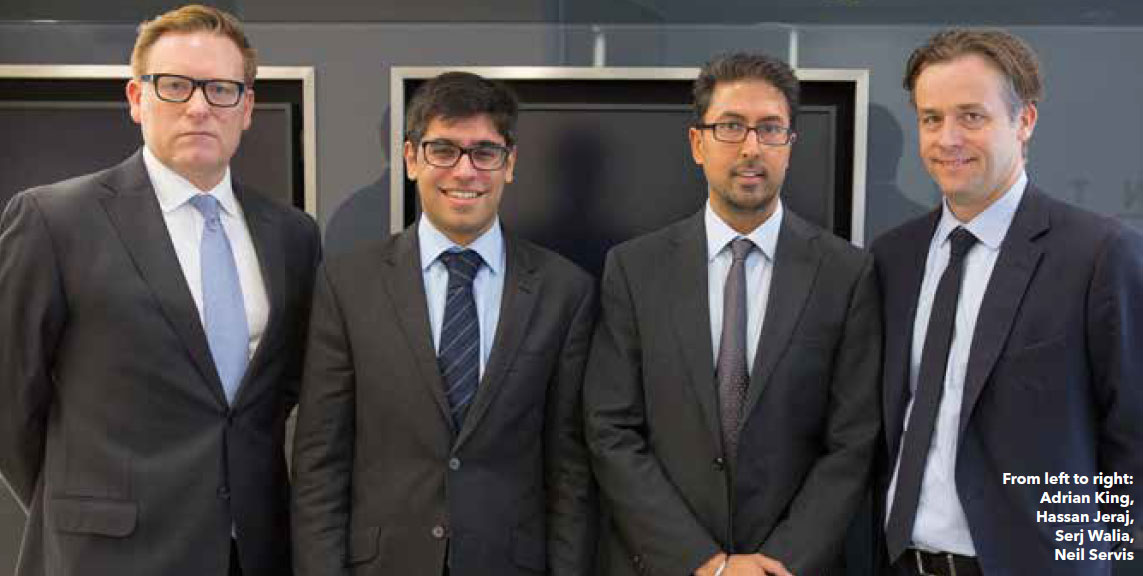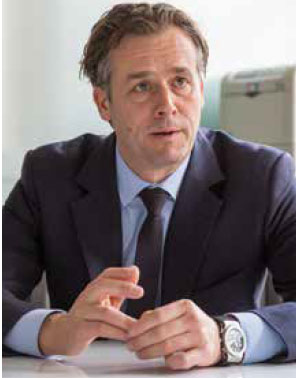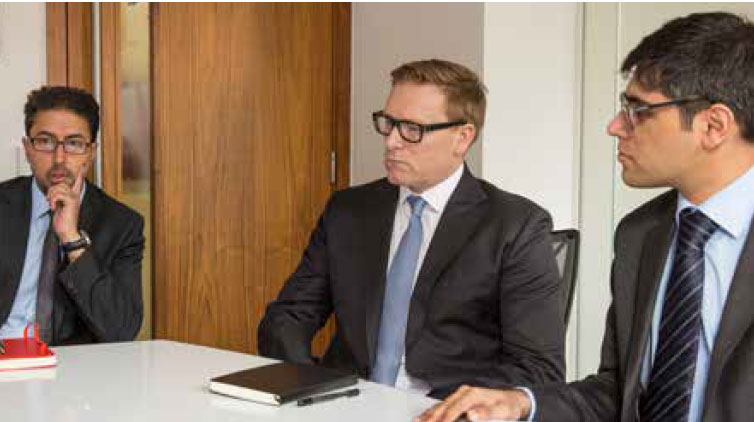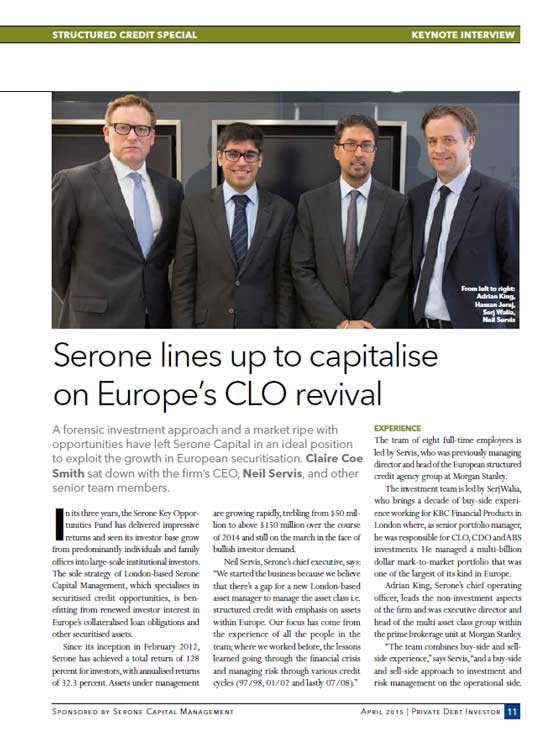Serone Lines up to Capitalise on Europe’s CLO Revival
A forensic investment approach and a market ripe with opportunities have left Serone Capital in an ideal position to exploit the growth in European securitisation. Claire Coe Smith sat down with the firm’s CEO, Neil Servis, and other senior team members.

Neil Servis, Serone’s chief executive, says: “We started the business because we believe that there’s a gap for a new London-based asset manager to manage the asset class i.e. structured credit with emphasis on assets within Europe. Our focus has come from the experience of all the people in the team; where we worked before, the lessons learned going through the financial crisis and managing risk through various credit cycles (97/98, 01/02 and lastly 07/08).”
EXPERIENCE
The team of eight full-time employees is led by Servis, who was previously managing director and head of the European structured credit agency group at Morgan Stanley.
The investment team is led by Serj Walia, who brings a decade of buy-side experience working for KBC Financial Products in London where, as senior portfolio manager, he was responsible for CLO, CDO and ABS investments. He managed a multi-billion dollar mark-to-market portfolio that was one of the largest of its kind in Europe.
Adrian King, Serone’s chief operating officer, leads the non-investment aspects of the firm and was executive director and head of the multi asset class group within the prime brokerage unit at Morgan Stanley.
“The team combines buy-side and sellside experience,” says Servis, “and a buy-side and sell-side approach to investment and risk management on the operational side.
Our over-riding thesis is deep fundamental credit analysis, followed by legal documentation scrutiny, then a mathematically modelled perspective. Added to that is a trading markto-market mentality in terms of managing the risk. We are not a buy-and-hold investor in this asset class, which we think is the way to manage the fund.”
THE EDGE
It’s an approach and a mix of skill set not easily found in Europe, but slightly more common in the States. Serone invests in both Europe and the US, targeting an annual return of 12 percent by investing across a range of securities, mainly mezzanine-level positions in CLOs, CDOs and ABS, as well as senior distressed bonds. The portfolio started off with a bias towards US assets, and for short periods in its brief history its exposure has been 100 percent US, though today it stands at roughly two-thirds European holdings.
Walia says: “We continually look at both the US and Europe from a relative value standpoint. We think it’s a mistake to look at one particular market in isolation, because you are seeing investors cross over from both sides of the Atlantic, and that materially affects the technical flows in the market. We are always very conscious of what’s going on in the US market, but we see best relative value today as being in Europe, and that’s going to be the focus.”
The fund constantly seeks out relative value between all its markets; both geographically, and by sector i.e. corporate credit, consumer and real estate.
The team says investors have woken up to the opportunities in structured credit in Europe, thanks in part to the advent of quantitative easing on this side of the Atlantic as the US programme ends. Both the European Central Bank and the Bank of England are now actively promoting the European securitised markets, where there is good relative value in credit products thanks to historically high spreads and low CLO default rates.
The Serone strategy is expected to perform in a low growth and low inflation environment, Walia says: “For our particular asset class we don’t necessarily need the actual recovery to play out, but that’s definitely a bonus. As the recovery occurs in Europe we will see debt-to-GDP ratios falling, which is a clear positive. We believe the best relative value to be found is in the corporate space and our focus is the leveraged loan space in Europe, via structured securitised products.”
They are tapping in to a large and diverse market, with exposure to different underlying asset classes across differing geographies, and benefiting from positions that are often more liquid than buying the underlying assets.
The fund takes minimal positions in peripheral European countries, with roughly 10 percent typically allocated in these geographies; their preference is core Europe.

TIME IS NOW
Servis argues the opportunities for total return are manifold, chief amongst them the maturity of the asset class, where peak issuance occurred in 2005-07 such that legacy structured products are approaching maturities, forcing potential liquidations. Regulatory uncertainties out of Basel III, Solvency II, the Volcker Rule and central bank policies have restricted the buying universe, creating new opportunities for alternative buyers, while control positions in event-sensitive securities may allow for unwind, liquidation and control of underlying collateral opportunities due to size.
Further catalysts for returns will result from refinancing driven by economic growth that enhances returns, leading to earlier prepayments of the underlying capital. Call and tender features in deals may enhance return with early return of capital, while the end of reinvestment periods could cause deals to pay down senior debt, deleveraging structures and resulting in an accelerated push to par.
Serone’s investment approach is driven by trading discipline and the ability to exploit best-value returns up and down the capital structure, across regions, and in primary versus secondary positions.
The investment process is key, Servis says: “We are pretty forensic in terms of the detail that we apply to each investment, and it’s a reasonably lengthy process. The devil is always in the detail so our focus is on the credit quality of assets we are buying, and then on top of that detailed in-house modelling and legal reviews.”
‘To support our investment approach we have invested a large amount of time developing our portfolio management system and integrating cleaned data to provide up-to-date credit analysis and data on the underlying collateral of the assets we invest in. The philosophy on the systems and quantitative side is to build rather than buy. That way we develop tools in line with our thinking’ King said.
The philosophy in terms of holding the assets is mark-to-market, Servis says. “What’s the asset worth today, and then if we think the asset would be worth less tomorrow we would sell it, which sounds like an obvious thing to say but that’s the way we think about things, we think about maximising the return, and we are always thinking about the exit,” he stated.

STRESS TESTS
The 20-year experience of the team in the asset class plays a large role in the art of portfolio construction and in the investment process, while stress-testing of the portfolio is also taken very seriously. Serone stress-tests the valuations of future cashflows in two ways, by stressing the discount margins, and by loss-adjusting the cash flows themselves, for example stressing future default rates. Stresses of each relevant parameter are applied instantaneously and in isolation from one another, and the stresses are assumed to remain over the future life of the fund.
Walia says: “The idea really is to see how the fund behaves under different states of the world, some of which are fairly benign. Then we start looking at the world under stressed and very stressed states, and also in upside, where the recovery exceeds our base-case expectations. That gives us a good sense of the range of how the overall portfolio performs, and we share that information with our investors.”
The team stress tests default rates, interest rates, credit spreads and currencies, and it is an approach that has attracted institutional backers. After launching with modest assets including own capital and money raised from family offices, friends and family, the Key Opportunities Fund took its first investment from large institutions a little over a year ago. Allocations from two continental European pension funds and one European insurance company look likely to be followed by more institutional support.
EUROPE MOVING UP
The credit opportunity in Europe is something the larger asset allocators now feel they need to be investing in. Serone’s approach of building a stable return over the cycle is also an obvious driver, along with an attractive risk-reward proposition. Hassan Jeraj, who works in investor relations at Serone said that the firm has daily discussions with investors who are invested in US-centric funds, and think that fair value may have been realised in those markets.
“Our pipeline is very strong with US investors coming in to Europe as QE starts here and ends there. That creates a lot of interest, as does where the Euro is, for US Dollar investors globally. In Europe, the size of the investor base is growing, and there’s demand coming out of Asia as well,” says Servis.
Serone was granted AIFMD authorisation by the Financial Conduct Authority last summer, and is looking to expand both headcount and AUM in 2015. With central banks talking up the benefits of securitisation, and with issues in Europe that will take a long time to resolve, the team believes it’s an investment opportunity that will be around a long time.
Walia concludes: “The CLO market has actually proven itself through the crisis, and come out of the other side extremely well. That’s a pretty sound foundation to build for the future, and the expectation is that, if you take the US as a lead, the European primary market is going to go from strength to strength.”
Please note references to Fund performance have been removed
Published
12 April 2015


